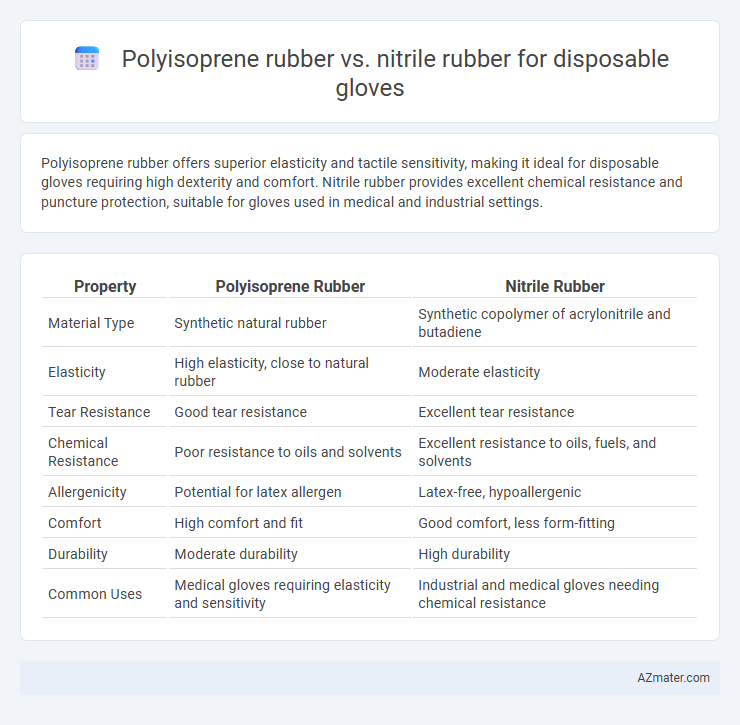Polyisoprene rubber offers superior elasticity and tactile sensitivity, making it ideal for disposable gloves requiring high dexterity and comfort. Nitrile rubber provides excellent chemical resistance and puncture protection, suitable for gloves used in medical and industrial settings.
Table of Comparison
| Property | Polyisoprene Rubber | Nitrile Rubber |
|---|---|---|
| Material Type | Synthetic natural rubber | Synthetic copolymer of acrylonitrile and butadiene |
| Elasticity | High elasticity, close to natural rubber | Moderate elasticity |
| Tear Resistance | Good tear resistance | Excellent tear resistance |
| Chemical Resistance | Poor resistance to oils and solvents | Excellent resistance to oils, fuels, and solvents |
| Allergenicity | Potential for latex allergen | Latex-free, hypoallergenic |
| Comfort | High comfort and fit | Good comfort, less form-fitting |
| Durability | Moderate durability | High durability |
| Common Uses | Medical gloves requiring elasticity and sensitivity | Industrial and medical gloves needing chemical resistance |
Introduction to Disposable Glove Materials
Polyisoprene rubber offers excellent elasticity and natural latex-like comfort, making it ideal for disposable gloves requiring high sensitivity and tactile performance. Nitrile rubber provides superior chemical resistance and puncture durability, preferred in medical and industrial settings where exposure to hazardous substances is a concern. Both materials balance protection and comfort, with polyisoprene suited for latex-sensitive users and nitrile favored in environments demanding robust barrier properties.
Overview of Polyisoprene Rubber Gloves
Polyisoprene rubber gloves offer superior elasticity and a natural latex feel without the allergenic proteins found in natural latex, making them ideal for sensitive skin environments. These gloves provide excellent tactile sensitivity and comfort, closely mimicking natural latex while reducing the risk of allergic reactions. Their resistance to tears and punctures, combined with high dexterity, makes polyisoprene gloves a preferred choice in medical and laboratory settings where precision and protection are critical.
Overview of Nitrile Rubber Gloves
Nitrile rubber gloves are synthetic, latex-free gloves known for their excellent chemical resistance, puncture resistance, and durability, making them ideal for medical, automotive, and industrial use. Compared to polyisoprene gloves, nitrile offers superior protection against oils, solvents, and certain hazardous substances while maintaining high levels of tactile sensitivity and comfort. The enhanced resistance to degradation from chemicals and increased shelf life make nitrile gloves a preferred choice for environments requiring robust barrier protection.
Chemical Composition: Polyisoprene vs Nitrile
Polyisoprene rubber is a natural polymer composed primarily of cis-1,4-polyisoprene units, offering excellent elasticity and tactile sensitivity ideal for disposable gloves. Nitrile rubber, a synthetic copolymer of acrylonitrile and butadiene, provides superior chemical resistance and puncture protection compared to polyisoprene. The chemical composition of nitrile gloves makes them better suited for handling oils, solvents, and hazardous chemicals, whereas polyisoprene gloves excel in comfort and biodegradability.
Physical Properties Comparison
Polyisoprene rubber offers superior elasticity and tactile sensitivity, making it ideal for tasks requiring precision and comfort. Nitrile rubber provides enhanced resistance to punctures, chemicals, and oils, ensuring durability in harsh environments. While polyisoprene excels in softness and flexibility, nitrile demonstrates greater tensile strength and abrasion resistance for robust applications.
Comfort and Fit: User Experience
Polyisoprene rubber disposable gloves offer superior comfort and fit due to their natural elasticity and softness, closely mimicking the feel of latex without causing allergic reactions. Nitrile rubber gloves provide a snug fit with excellent puncture resistance but can feel stiffer and less flexible, impacting prolonged wear comfort. Users often prefer polyisoprene for extended use tasks requiring dexterity and tactile sensitivity, while nitrile suits environments demanding chemical and puncture protection.
Chemical and Puncture Resistance
Polyisoprene rubber offers excellent flexibility and high tensile strength but provides limited chemical resistance compared to nitrile rubber. Nitrile rubber excels in chemical resistance, particularly against oils, fuels, and certain solvents, making it ideal for handling hazardous substances. While nitrile also demonstrates superior puncture resistance, polyisoprene gloves deliver better tactile sensitivity and comfort for precision tasks.
Allergenicity and Skin Sensitivity
Polyisoprene rubber gloves provide a natural latex alternative with significantly reduced allergenicity, making them suitable for individuals with latex sensitivity while maintaining excellent elasticity and tactile sensitivity. Nitrile rubber gloves are synthetic, latex-free, and hypoallergenic, offering superior resistance to punctures and chemicals, thereby minimizing the risk of skin irritation and allergic reactions. Both materials ensure enhanced safety for users with sensitive skin, but nitrile is often preferred in medical and industrial settings due to its broader chemical resistance and non-protein allergen properties.
Cost and Availability in the Market
Polyisoprene rubber gloves generally cost more due to complex manufacturing processes and limited supply compared to nitrile gloves, which benefit from large-scale synthetic production and lower raw material expenses. Nitrile gloves dominate the market with widespread availability and consistent pricing, making them a cost-effective choice for disposable gloves. Polyisoprene gloves, while preferred for their latex-like elasticity, remain less accessible and pricier, especially in high-demand situations.
Choosing the Right Glove for Your Application
Polyisoprene rubber offers excellent elasticity, comfort, and tactile sensitivity, making it ideal for medical and laboratory applications requiring precision and reduced allergy risk. Nitrile rubber provides superior chemical resistance, durability, and puncture protection, suitable for industrial and chemical handling tasks. Selecting the right glove depends on balancing requirements for sensitivity, protection level, and potential latex allergies in your specific work environment.

Infographic: Polyisoprene rubber vs Nitrile rubber for Disposable glove
 azmater.com
azmater.com